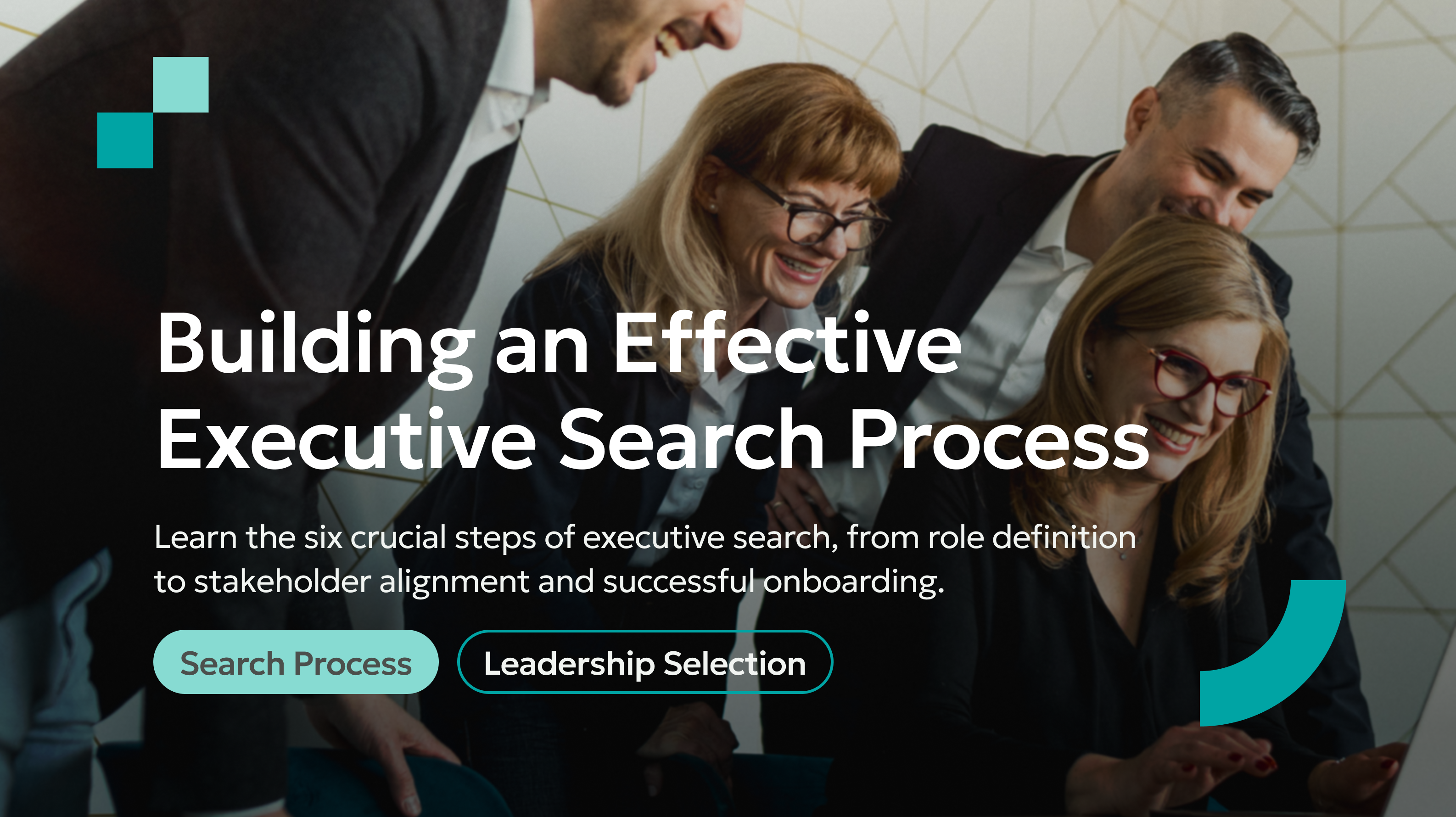Key Takeaways
- Define clear objectives and align with senior leadership to set the foundation for success.
- Develop a complete sourcing strategy, including market mapping, referrals, and engaging passive candidates.
- Leverage tools, structured interviews, and coaching to improve hiring decisions and onboarding.
Have you ever started your executive search process only to realize that what works for general roles doesn’t work for hiring executives? You’re not alone.
Executive search represents a fundamentally different approach from traditional recruitment. It’s about deep market mapping, confidential direct outreach to top-tier candidates, and goes beyond posting job listings or sourcing from public channels.
A mis-hire at the executive level can cost companies up to 213% of their annual salary.
If this made your heart skip a beat, don’t worry! The essence lies in strategic client consultation, thoughtful candidate engagement, and precise cultural alignment while navigating exclusive professional networks. In today’s article, we will dive into all of these elements.
Building Your Executive Search Process
Step 1: Define the Role and Search Objectives
Before exploring channels or crafting a messaging strategy for hiring, clarify the vision for the role. At GetFrankly, we collaborate with the leadership team to define the role’s requirements, strategic importance to the organization’s plan, and the soft skills needed for cultural fit.
Here are some guiding questions:
- What strategic challenges will this executive need to tackle in the next 3-5 months? What about the next 1-3 years?
- How will this role contribute to our organization’s long-term vision?
- What type of leader do we need to drive our culture forward?
- What are the deal breakers for us, and are there things we can compromise on?
Step 2: Market Mapping
Start by understanding your industry’s talent landscape to identify potential pool candidates.
Research Industry Trends
First, you should look into your industry’s landscape to identify talent pools. Use tools like LinkedIn Talent Insights, Glassdoor, or specialized market research platforms to explore where potential candidates are currently thriving. For instance, you could analyze key competitors or related industries that house executives with transferable skills.
You can also use resources like Gartner reports, PwC’s industry insights, or the National Institute of Statistics public reports. Also, check out our 2025 & Beyond Trends Report.
At GetFrankly, we conduct meticulous, confidential research to identify relevant industry leaders and evaluate competencies, cultural alignment, and strategic potential. Our approach involves analyzing client networks and markets to identify ideal candidates, even those not actively seeking new opportunities.
We specifically focus on the following:
- Emerging technologies or innovations: Relevant tools or advancements for the role.
- Market demands and skills gaps: The skills needed to address current industry challenges.
- Regulatory changes: Shifts in compliance or governance influencing executive decisions.
- Competitor strategies: Leadership trends at rival organizations.
- Regional talent dynamics: Geographic trends, including the impact of remote work.
Set Competitive Compensation Benchmarks
Review compensation benchmark studies to create attractive yet budget-conscious packages. At GetFrankly, we rely on multiple tools for benchmarks and have access to paid relevant studies. Once you have the data, you can cross-reference industry averages with regional cost-of-living data to create a package that stands out and does not exceed your budget.
Personalized Approach and Role Positioning
The next step is to create a personalized approach for each role.
Top-tier positions aren’t simply filled – they’re strategically sold. We craft compelling narratives about each role’s unique value proposition, positioning our client as an attractive career partner. Every candidate interaction is an opportunity to strengthen our professional network and build lasting trust.
Identify Passive Candidates
A critical step in market mapping is identifying executives not actively seeking new opportunities. We use our extensive professional networks, industry connections, and board-level relationships to surface potential candidates.
Reaching Beyond Digital Footprints
But what about those seasoned executives who maintain a minimal online presence?
We excel at connecting with these high-value candidates.
We ensure no stone is left unturned through our established networks of industry insiders, confidential referrals, and strategic relationships with key stakeholders.
When a candidate is crucial to our talent pool, we leverage multiple channels – from discrete phone outreach to trusted intermediaries and carefully cultivated professional connections. Our commitment to thoroughness means we go far beyond digital platforms to identify and engage the right executive talent.
Step 3: Develop a Sourcing Strategy and Build a Talent Pipeline
Create a Multi-Channel Sourcing Plan
As we already mentioned, sourcing must go beyond traditional job postings for executive search. To access top-tier candidates, utilize internal leadership networks, industry conferences, and exclusive professional associations. LinkedIn and executive databases can provide visibility, but direct engagement through peer referrals and discreet outreach is crucial. Leverage market research and competitor mapping to identify high-caliber executives who may be open to a strategic career move.
Leverage Referrals
Executive hiring thrives on trust. Encourage board members, senior leaders, and key industry stakeholders to refer potential candidates. Consider establishing an executive referral program that rewards discretion and quality recommendations. Additionally, consider engaging trusted advisors, such as business consultants or investors, who often have insight into high-potential leaders looking for new opportunities.
Engage Passive Candidates
Top executives are rarely active job seekers, so building relationships over time is essential. To foster connections participate in industry events, leadership summits, and private roundtables. Position your organization through thought leadership by contributing to industry reports, hosting webinars, or publishing executive insights. Personalized outreach, based on understanding an executive’s career trajectory and aspirations, helps establish meaningful connections long before a hiring need arises.
Step 4: Screen and Shortlist Candidates
Implement Structured Screening Criteria
Implementing the multi-channel strategy will bring many potential candidates. The next step is to shortlist them.
Here are some metrics that you can use to screen them effectively:
- Leadership effectiveness: Assess candidates’ ability to lead teams and drive organizational goals. Use behavioral interview questions and leadership assessment tools like Gallup StrengthsFinder.
- Cultural fit: Evaluate how well a candidate’s values align with the company’s culture through personality tests like MBTI or cultural alignment frameworks.
- Strategic thinking: Check their ability to think strategically using case studies or situational judgment tests tailored to the company’s industry challenges.
- Past performance metrics: Analyze the candidate’s previous KPIs and achievements to predict their potential contribution to the company.
Assess Core Competencies
Especially with executive recruitment, you should look into assessing core competencies.
Our recommendation is to look into:
- Leadership skills: Evaluate candidates’ ability to lead teams by asking scenario-based questions, such as how they’ve managed large-scale organizational changes.
- Strategic decision-making: Test their decision-making ability with real-world business case studies or role-playing exercises. For example, ask how they would prioritize projects with limited resources.
- Technical expertise: Use job-specific tests or certifications. For example, for a CFO role, review their experience with financial modeling and audit processes using tools like Tableau.
- Communication Skills: Measure their ability to articulate ideas clearly by asking for presentations or reviewing their past public speaking engagements, such as keynote sessions or panel discussions.
Pro tip: Revisit the role’s vision to align these assessments with the most important competencies.
Step 5: Conduct Insightful and Structured Interviews
Prepare Targeted Interview Questions
Use the core competencies identified earlier to craft targeted questions. Examples:
- Leadership skills: “Describe a time when you led a team through a significant change. How did you address resistance, and what was the outcome?”
- Strategic decision-making: “With limited resources and multiple high-priority projects, how would you decide which to prioritize?”
- Technical expertise: “For a CFO role: Can you walk us through a financial model you developed? What challenges did you face?”
- Cultural fit: “Tell us about a conflict within a team due to differing work styles. How did you handle it?”
- Communication skills: “Provide an example of a presentation you delivered to senior stakeholders. How did you ensure your message was impactful?”
Involve Key Stakeholders
Hiring an executive usually requires multiple steps in the interview process. We recommend engaging various stakeholders in the process. You might consider:
- Senior leadership panels: Assemble a panel of senior leaders to participate in interviews. For example, invite the CEO or CFO to assess strategic alignment and long-term fit.
- Cross-functional insights: Include representatives from teams with whom the candidate will closely interact. For instance, hiring a Chief Marketing Officer involves leaders from sales, product, and customer success teams to review the collaborative potential.
- Structured feedback loops: Create a standardized form for stakeholders to provide feedback after each interview.
- Role-play exercises: Conduct situational role-play sessions with stakeholders, where the candidate addresses a hypothetical challenge relevant to the position. For example, ask a COO candidate to design a crisis response plan with the executive team.
- Consensus meetings: Hold post-interview debriefs where stakeholders share their impressions and collectively weigh the candidate’s strengths and weaknesses. Use tools like Miro for visual collaboration during these discussions.
Step 6: Make the Final Decision and Secure Stakeholder Buy-In
The final step is to decide and prepare a competitive offer for the chosen candidate. Taking into consideration that we are talking about an executive role, it is essential to include some of the following elements in your offer:
- Comprehensive compensation: Outline the base salary, bonuses, equity options, and other incentives. For example, performance-based bonuses tied to measurable goals can make the offer more appealing.
- Benefits and perks: Highlight unique offerings like wellness programs, flexible working arrangements, or executive coaching.
- Relocation support: If needed, include housing allowances or visa assistance for international hires.
Making sure the Hiring Manager has a Clear Onboarding Plan
Congratulations—you’ve found the ideal executive! The final step is ensuring their success with a comprehensive onboarding plan. Collaborate with the hiring manager to develop a detailed roadmap, including:
- Resources and tools: Provide access to relevant systems and support materials.
- Organizational orientation: Familiarize them with the company’s culture, goals, and teams.
- KPIs: Define clear, measurable objectives for their first 90 days and beyond.
Enhancing Your Executive Search Process with GetFrankly
At GetFrankly, we go beyond traditional recruitment to forge lasting relationships. We leverage our deep industry expertise to build trust and maintain connections with exceptional leaders, whether they’re actively seeking opportunities or not. Every interaction is an opportunity to expand and strengthen our talent network, ensuring we can swiftly deliver exemplary leadership talent when opportunities arise.
We prioritize one-on-one discussions with C-level executives, offering complimentary career coaching and representation services – even for opportunities outside our immediate portfolio. This commitment to executive development reflects our belief in building genuine, long-term partnerships rather than transactional relationships.
While we utilize cutting-edge sourcing tools for market mapping and data analysis, our true differentiator is combining technology with human intuition. We look beyond the data – actively listening to clients and candidates, analyzing career trajectories, and leveraging personal relationships to identify leaders who align with our clients’ needs.
We focus on what truly matters: how candidates align with your organization’s values and culture. We understand leadership needs not just for today but for tomorrow. This means carefully evaluating professional capabilities and how a candidate will integrate and add long-term value.
At GetFrankly, executive search isn’t simply recruitment – it’s a strategic partnership. We bring in leaders who don’t just meet requirements; they elevate standards.
FAQs: Executive Search Process
What is the difference between an executive search process and traditional recruitment?
The executive search process focuses on finding top-tier leaders through deep market mapping, direct outreach, and personalized strategies, unlike traditional recruitment, which often relies on job postings.
Why is cultural alignment important in executive hiring?
Cultural alignment ensures executives share the organization’s values and vision, leading to better integration, collaboration, and long-term success within the company.
How do you identify passive candidates for executive roles?
Passive candidates are identified through confidential networking, referrals, and industry insights. We also leverage professional connections to find leaders with minimal online presence.
What tools can improve executive screening and assessments?
Leadership assessment tools like Gallup StrengthsFinder, cultural fit tests, and situational judgment exercises effectively evaluate strategic thinking and soft skills.
How do you ensure the success of an executive post-hire?
Success is ensured through comprehensive onboarding, including organizational orientation, access to resources, and clear KPIs for their first 90 days and beyond.







